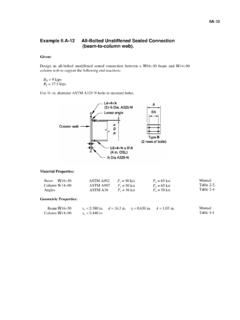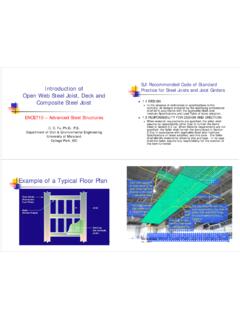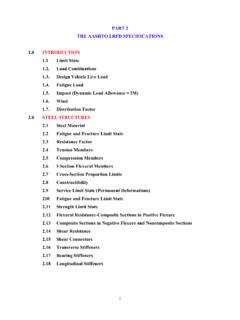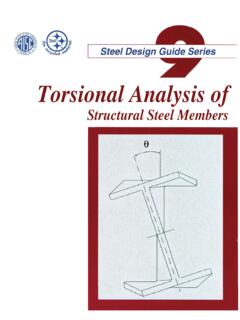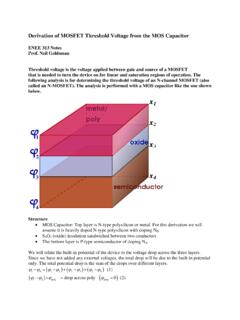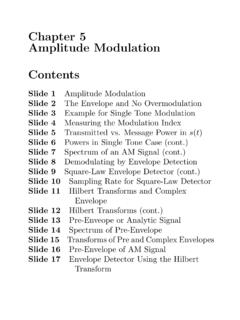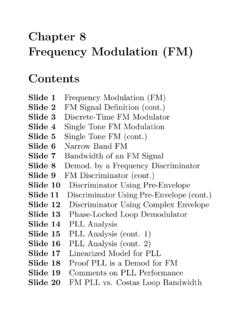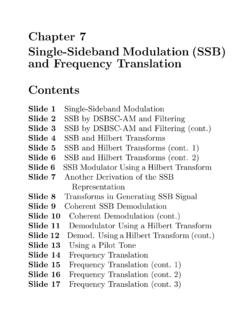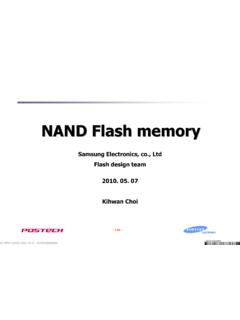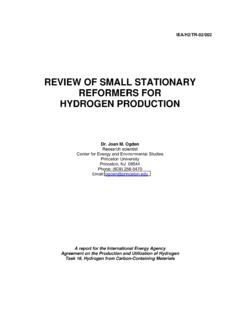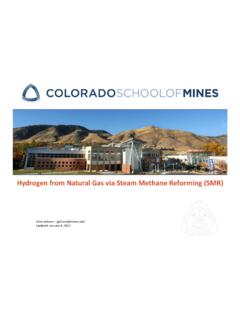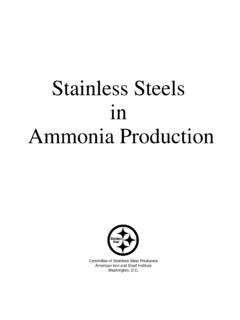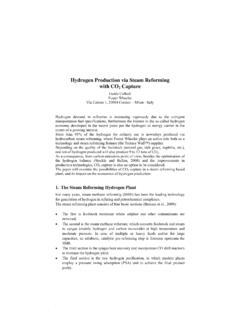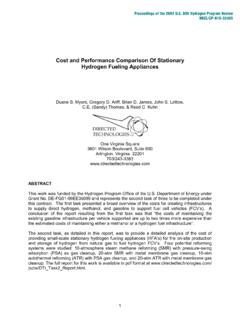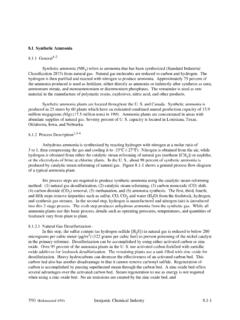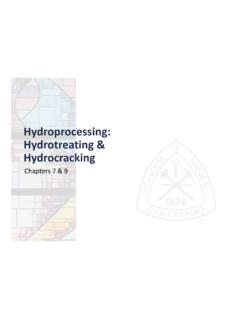Transcription of Aspen Plus Ammonia Model - UMD
1 Aspen Plus Ammonia ModelAspen PlusCopyright 2008-2015 by Aspen Technology, Inc. All rights Plus , Aspen Properties , the Aspen leaf logo and Plantelligence and Enterprise Optimization are trademarksor registered trademarks of Aspen Technology, Inc., Bedford, other brand and product names are trademarks or registered trademarks of their respective document is intended as a guide to using AspenTech's software. This documentation contains AspenTechproprietary and confidential information and may not be disclosed, used, or copied without the prior consent ofAspenTech or as set forth in the applicable license agreement. Users are solely responsible for the proper use ofthe software and the application of the results AspenTech has tested the software and reviewed the documentation, the sole warranty for the softwaremay be found in the applicable license agreement between AspenTech and the user.
2 ASPENTECH MAKES NOWARRANTY OR REPRESENTATION, EITHER EXPRESSED OR IMPLIED, WITH RESPECT TO THIS DOCUMENTATION,ITS QUALITY, PERFORMANCE, MERCHANTABILITY, OR FITNESS FOR A PARTICULAR Technology, Crosby DriveBedford, MA 01730 USAP hone: (1) (781) 221-6400 Toll Free: (1) (888) 996-7100 URL: Introduction ..22 Components ..33 Process Physical Chemical Reactions ..9 reforming Monoxide Conversion .. 12 Carbon Dioxide Removal .. 13 Methanation 15 Synthesis Unit .. 166 Simulation Simulation Results ..208 Conclusions ..219 References ..2221 Introduction1 IntroductionThis Model simulates an Ammonia Production process using natural gas as afeedstock. This Model includes the following features: A set of chemical species and property parameters for this process. Typical process areas including: Desulfurization, reforming Unit, CarbonMonoxide Conversion, Carbon Dioxide Removal, Methanation Unit,Synthesis Unit, Refrigeration and the main streams connecting theseunits.
3 Usability features such as an Excel file which allows the user to collectsimulation results from the synthesis reactor. Definition of property Model parameters with user Components32 ComponentsThe table below lists the components modeled in the Ammonia plant nameFormulaNH3 CONVAMMONIANH3H2 CONVHYDROGENH2N2 CONVNITROGENN2CH4 CONVMETHANECH4 ARCONVARGONArCOCONVCARBON-MONOXIDECOCO2 CONVCARBON-DIOXIDECO2H2 OCONVWATERH2OO2 CONVOXYGENO2C2H6 CONVETHANEC2H6C3H8 CONVPROPANEC3H8N-BUTANECONVN-BUTANEC4H10 I-BUTANECONVISOBUTANEC4H10N-PENTANCONVN- PENTANEC5H12I-PENTANCONVI-PENTANEC5H12N- HEXANECONVN-HEXANEC6H14N-HEPTANCONVN-HEP TANEC7H16 SULFURCONVSULFUR-8-ATOMIC-GASS8H2 SCONVHYDROGEN-SULFIDEH2SH3O+CONVH3O+H3O+ OH-CONVOH-OH-NH4+CONVNH4+NH4+NH2 COO-CONVCARBAMATENH2 COO-HCO3-CONVHCO3-HCO3-CO3--CONVCO3--CO3 -2NH4 HCO3 SSOLIDAMMONIUM-HYDROGEN-CARBONATENH4 HCO3NH4 HCO3 CONVAMMONIUM-HYDROGEN-CARBONATENH4 HCO3 Every component is not
4 Included in all the plant sections in order to keep themodel as simple as possible. The higher hydrocarbons (C2-C7) are onlyincluded in the reformer section. The CO2 Removal section only includes ions42 Componentsand electrolytes. The synthesis and refrigeration sections only include thecomponents H2, N2, Ar, CH4, NH3 and Process Description53 Process DescriptionAmmonia is produced basically from water, air, and energy. The energysource is usually hydrocarbons, thus providing hydrogen as well, but may alsobe coal or electricity. Steam reforming of light hydrocarbons is the mostefficient route, with about 77% of world Ammonia capacity being based onnatural Process DescriptionFigure 1 Block diagram of the steam/air reforming plants using natural gas as a feedstock include the following units:Natural Gas DesulfurizationThe natural gas is delivered as dry gas containing a maximum of 40 ppm byweight of sulfur, which is a poison for the reformer catalyst.
5 Thedesulfurization unit reduces the sulfur content to about 5 ppm byhydrogenating it to hydrocarbons and hydrogen sulfide and then absorbingthe hydrogen sulfide in zinc Process Description7 reforming UnitThis unit contains two sections, one is primary reforming , and another issecondary reforming . The desulfurized hydrocarbon feed is reformed tohydrogen and carbon oxides in the presence of steam in the primaryreformer, and additionally with hot air in the secondary reformer. Thereformed gas contains about vol% Monoxide ConversionIn the CO-shift conversion, the major part of the CO contained in thereformed gas is catalytically converted to CO2in two catalytic stages, the firstat high temperature and the second at low Dioxide RemovalThe carbon dioxide is removed from the converted gas in the captured by NH3and it will generate ammonium hydrogen carbonateas byproduct.
6 The purified gas with about vol% CO2is called UnitEven small quantities of CO ( vol%) and CO2( vol%) are poisons forthe Ammonia synthesis catalyst. Thus they are reacted to methane over anickel catalyst. The residual content of CO + CO2is less than 10 UnitThe synthesis gas is pressurized by a centrifugal compressor to approximately300 bar and hydrogen and nitrogen are catalytically converted to ScrubbingThe Ammonia in the purge gas from the Ammonia unit is recovered in thetailgas scrubbing unit and fed to a refrigeration unit. The treated purge gas isused as fuel for the primary reformer. The building blocks offered in thispackage do not Model this section of the Ammonia gas in the synthesis loop is liquefied by Ammonia evaporation inthe Ammonia chiller and discharged as feed to the urea process and toammonia storage.
7 The building blocks offered in this package do not modelthis section of the Physical Properties4 Physical PropertiesEquation-of-state models provide an accurate description of thethermodynamic properties of the high-temperature, high-pressure conditionsencountered in Ammonia plants. The Redlich-Kwong modification RKS-BMwas chosen for this application. In most cases, the Model parameters weretaken from the Aspen physical property databanks. Special accuracyimprovements were made to the RKS-BM Model as follows: The pure-component properties of Ammonia were modified to improve thevapor pressure and enthalpy of vaporization, which is important for thesynthesis section. The binary interaction parameters of H2, N2, Ar and CH4with ammoniawere modified in order to obtain accurate solubilities of these species inammonia, which is important for the synthesis and refrigeration sections.
8 The binary parameters of the air system (N2, O2, Ar) were modified inorder to enable an accurate simulation of the vapor-liquid equilibrium inthe nitrogen NRTL method and RK equation of state are used to compute liquidand vapor properties respectively in the CO2 Removal Unit. The NRTL parameters for electrolyte pairs were regressed against VLE data from Maurer(1988)[1]. NH3is selected as Henry-components to which Henry s law isapplied and the Henry s constants are Chemical Reactions95 Chemical ReactionsReforming UnitThe main reaction occurring in the reformer is the conversion of methane to amixture of CO, CO2and H2:2243H+COOH+CH (Endothermic)(A-1)222H+COOH+CO (Exothermic)(A-2)The kinetics expression for Reaction A-1, the reforming reaction, (Moe andGerhard, 1965)[2]is as follows:422224223lb mole379hr ftCHH OHCOK PPP PRk (A-3)The partial pressures are converted to expressions of molar quantities byassuming ideal gas behavior.
9 The factor 379 is needed to convert the unitsfrom SCF to moles. 432222224232 HCOCHH O -379k PRKPSSSS (A-4)SS is the total number of moles of mixture per mole of methane and Gerhard arbitrarily set the P3term to in order to correlate theirdata taken from pressures above atmospheric. Therefore, the final form ofthe Model does not have a P3term, but is lumped in with the specific rateconstant k2as: (A-5)The factor Ac, catalyst activity, is used in the Model to give a reasonablereactor performance for the methane conversion. It may be adjusted suchthat reactor performance matches plant data. The equilibrium constant, K2,with units of atm2, is equal to K1K3. Hyman (1967)[3]gives:2149, (A-6)105 Chemical Reactions 8, below 1,100 FtK (A-7) 7, above 1,100 FtK (A-8)where, t is the temperature in equilibrium is assumed for the water shift reaction for which thefollowing holds:222(H )(CO )(H O)(CO)3=K(A-9)The reaction kinetics have been implemented in user kinetics Fortransubroutines of the RPlug Model .
10 The Fortran subroutines are REFKIN, DRATE,and KFORMC. Subroutines REFKIN and KFORMC are interface routinesnecessary to interface the Aspen Plus RPlug Model with DRATE, the Fortrankinetics subroutine developed by Mok (1982)[4].The pressure drop expression adopted is as follows: - PZZdz (A-10)Where,Z:tube length (ft)P:pressure (atm)Pfact: pressure drop factor (a function of catalyst characteristics)or: (A-11)The pressure drop expression has been implemented as a user pressure dropFortran subroutine of RPlug Model . The Fortran subroutine is the net reaction in the primary reformer is endothermic, the heat-transfer rate is critical to the rate of reaction in the tube. The heat-transferrate is determined by the tube inside and outside heat-transfer coefficients,the flame temperature, and the gas temperature.
